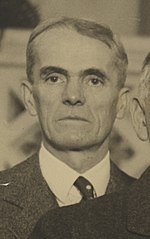Walter S. Adams
| Walter Sydney Adams | |
|---|---|

Walter Sydney Adams
|
|
| Born |
December 20, 1876 Antioch, Turkey |
| Died | May 11, 1956 (aged 79) Pasadena, California, U.S. |
| Nationality | United States |
| Alma mater |
Dartmouth College University of Chicago |
| Awards |
|
| Scientific career | |
| Fields | Astronomy |
| Institutions |
Mount Wilson Observatory Yerkes Observatory |
Walter Sydney Adams (December 20, 1876 – May 11, 1956) was an American astronomer.
Adams was born in Antioch, Turkey to Lucien Harper Adams and Nancy Dorrance Francis Adams, missionary parents, and was brought to the U.S. in 1885 He graduated from Dartmouth College in 1898, then continued his education in Chicago and in Germany. After returning to the U.S., he began a career in Astronomy that culminated when he became director of the Mount Wilson Observatory.
His primary interest was the study of stellar spectra. He worked on solar spectroscopy and co-discovered a relationship between the relative intensities of certain spectral lines and the absolute magnitude of a star. He was able to demonstrate that spectra could be used to determine whether a star was a giant or a dwarf. In 1915 he began a study of the companion of Sirius and found that despite a size only slightly larger than the Earth, the surface of the star was brighter per unit area than the Sun and it was about as massive. Such a star later came to be known as a white dwarf. Along with Theodore Dunham, he discovered the strong presence of carbon dioxide in the infrared spectrum of Venus.
Adams died at the age of 79 in Pasadena, California.
Awards and honors
...
Wikipedia
